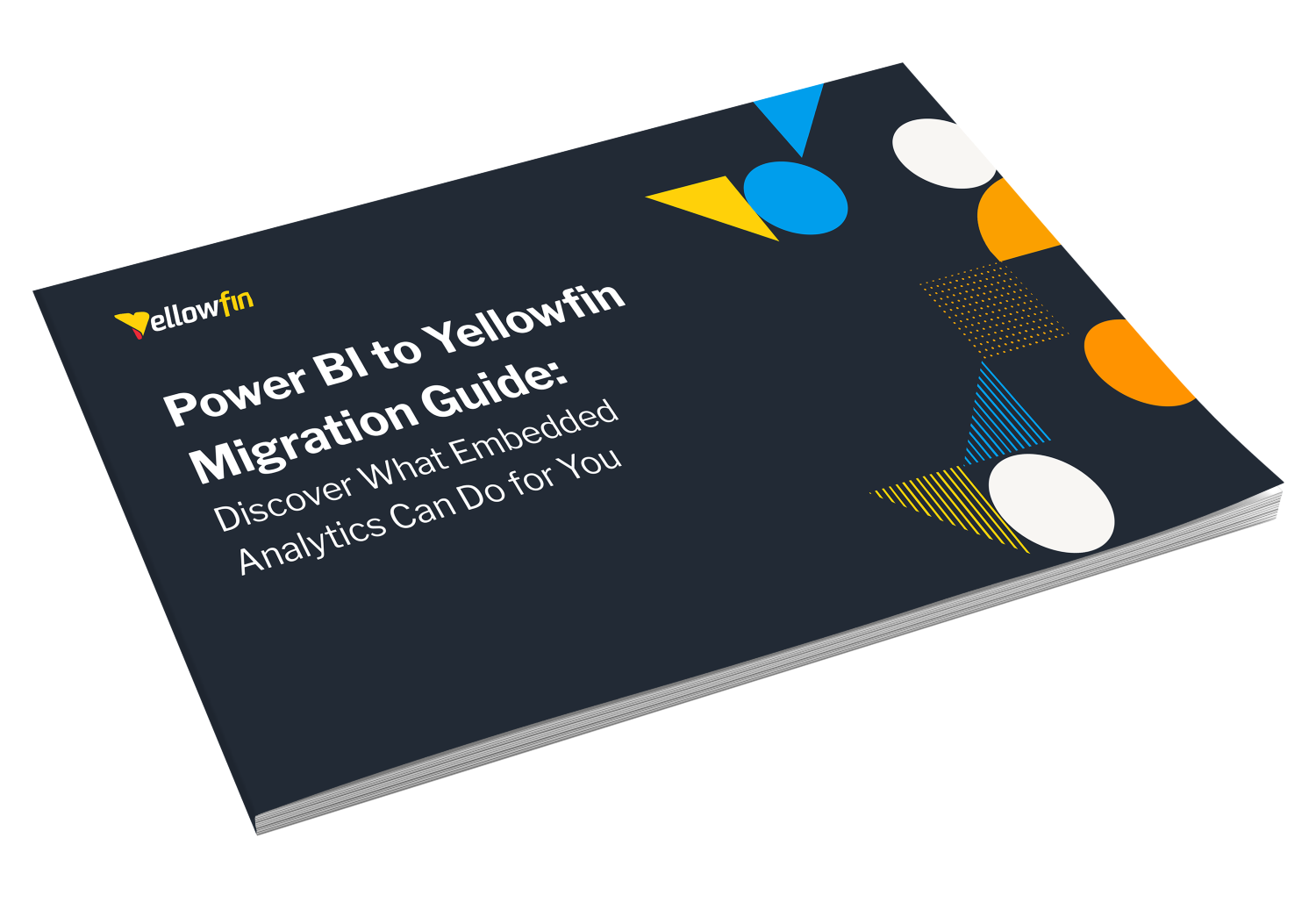
Power BI Embedded: Is it Your Best Choice for Analytics and Reporting?
Microsoft Power BI is a ubiquitous business intelligence (BI) solution entry point that can create a good foundation for analytics capabilities at any company. Its Power BI Embedded tier allows for embedding data visualizations, dashboards and reports into your applications, while using the broader Microsoft Azure Cloud infrastructure.
The key challenges Power BI Embedded presents, however, is complexity. Its deployment approach is decentralized, with multiple individuals and teams building solutions that can be interrelated. Complicated pricing models and a lack of design and embedding flexibility means new users can often get lost as quickly as they get started.
A seamless, easy-to-use embedded analytics platform is one of the most important competitive differentiators in the market today, but to unlock its many benefits, you need a modern solution to match several requirements. This blog will examine Power BI Embedded in-depth to help your team assess if it’s the best choice for your use case.
What is Power BI Embedded?
Power BI is a cloud-based software-as-a-service (SaaS) business intelligence (BI) and analytics platform available as a standalone service, or as part of the broader Microsoft Fabric data analytics platform (released in 2023). The platform comes in a number of different configurations, including:- Power BI Pro and Power BI Premium (per-user license tiers of Power BI)
- Power BI Desktop (a traditional Windows application for local systems)
- Power BI Service (also called Power BI Online)
- Power BI Mobile
- Power BI Embedded (also called PBIE)
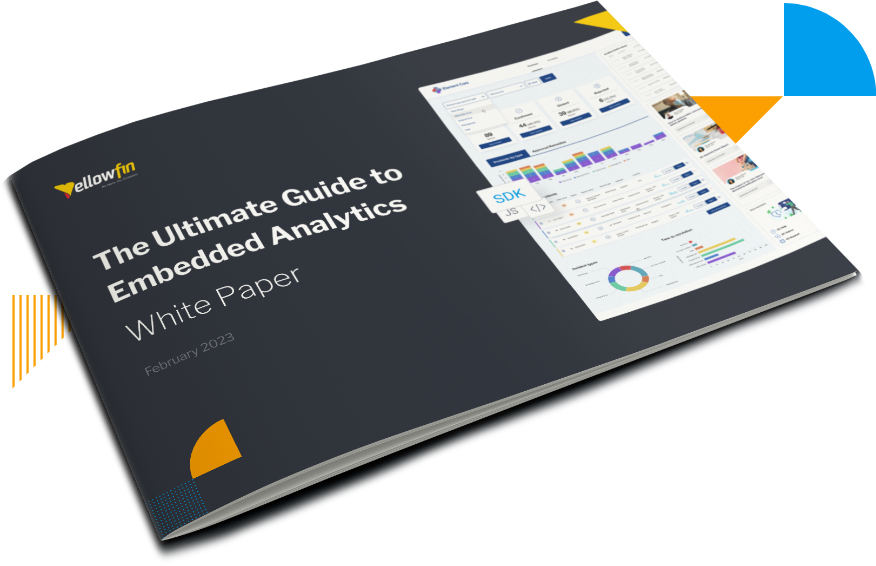
Who is Power BI Embedded for?
Power BI Embedded is a capable analytic solution that offers deep synergy with the broader Microsoft software stack and Azure Cloud it falls under. It currently offers two solutions that target the different embedding requirements for enterprise-sized companies and smaller ISVs:1. Embed for your customers
This allows businesses to embed analytic content created with Power BI into an existing application. External users can explore data, stored on a PowerBI Embedded capacity, without having to log into PowerBI.com or have an existing user license. This means there is no need for the user to switch windows to Power BI itself to view the data. They cannot edit or create new content from the embedded content, however. For ISV and SaaS companies, this tier of Power BI Embedded can provide a good way to integrate a dashboard or report directly into your app, without users needing Power BI accounts, and customers can access analytics securely and seamlessly without needing separate credentials. However, because of Power BI’s architectural dependencies on Microsoft Azure, there is some inflexibility in being able to further customize the look and integration of dashboards and reports as extensively and easily compared to other modern BI solutions. The content will display Power BI branding, making it harder to brand it as your own.2. Embed for your organization
Allows ISVs or enterprise companies to embed analytic content created with Power BI into an existing application, but requires the user to sign in with their Power BI credentials and authenticate against existing user permissions. This suits large enterprises who want to bring Power BI content directly into their work applications for internal users, while ensuring pre-set access permissions to the data (i.e. users can only access and explore the data that their individual Power BI license permits). PBIE makes the most sense to consider as an embedded BI solution for enterprise companies already using Microsoft tools or Azure infrastructure and who already have in-house developers experienced in creating analytic content (reports) with Power BI for other non-technical business professionals and customers to consume. For example, any business using Microsoft Entra ID (formerly Azure Active Directory) for identity and access management, or Azure Cloud for infrastructure will find embedded Power BI to be a natural fit with their existing operational model.What are the challenges of Power BI Embedded?
The fact is Power BI Embedded (and other versions) are highly platform dependent and intertwined with Azure and Fabric. If your business lacks familiarity with Microsoft’s capacity plans and how to create a dashboard and report in Power BI, you need to invest substantial time and money in learning its technical requirements. However, that is easier said than done with so many complicated Power BI pricing tiers, the inherent complexity of its numerous service offerings (with a confusing number of product names and re-brandings) and the multiple Azure-specific integrations required to get up and running, and costs for capacity can quickly spiral.What use cases is Power BI Embedded ideal?
Despite its complexities, PowerBI Embedded is popular for many reasons, and it’s worth understanding its various advantages and disadvantages. The following section will help you better assess whether embedded Power BI is the best option for your analytics adoption, and break down its biggest pros and cons.1. Strong data security
As part of Microsoft Azure Cloud, Power BI Embedded offers enterprise-grade data security, data governance and data compliance standards (GDPR, HIPAA, etc) and has native integration with the Microsoft Entra ID identity and access management (IAM) solution. This makes it a good option for businesses in industries such as finance, government or healthcare that need to enforce very strict role-based access controls and data privacy for reports and dashboards shared with external and internal users, and which contain sensitive business data.
2. Data connectors
Power BI has several data connectors that enable ISVs and SaaS companies to integrate data from numerous disparate sources, such as database connectors with on-premise servers and cloud platforms (SQL Server, Oracle, SAP, Amazon RedShift, etc) and third-party service connectors (Salesforce, Google Analytics, Dynamics 365, etc). Its wide range of support for data connectivity can help eliminate the need for custom integrations or ETL processes and reduce overall development time.3. Synergy with Microsoft services
As already mentioned, PBIE’s native compatibility with Microsoft’s software ecosystem can help streamline the deployment of reports and dashboards for businesses already invested in the Azure platform, and reduce the learning curve for developers accustomed to Microsoft technologies. Azure, Fabric and the wider Power BI service also get regular updates and patches that help teams keep features up-to-date.When to choose a Power BI alternative?
While Power BI Embedded offers compelling strengths, certain scenarios and business use cases might favor an evaluation of other embedded analytics solutions on the market. Understanding these limitations can help you make a more informed decision when choosing a solution amongst the best Power BI alternatives:1. When you want to avoid vendor lock in
Committing to Power BI Embedded means you are deeply integrating your analytics into Microsoft's ecosystem. While this offers seamless connectivity within Azure, it can create a significant dependency on Microsoft's platform, tools, and pricing structure. Migrating to a different embedded analytics solution in the future, due to evolving business needs, cost considerations, or strategic shifts could be more complex and resource-intensive than expected, and require extensive refactoring of your software. While Power BI Embedded can be embedded into applications that are not hosted by Azure, the tool ultimately still depends on Azure services to host and authenticate the usage of any embedded dashboards or reports. This can prevent your developers from leveraging any other tools used across other services that offer more agnostic infrastructure options, such as Amazon Web Services (AWS) or Google Cloud. With all this in mind, it’s important to take the time to understand the importance of how to avoid BI vendor lock-in, and other solutions that offer more open architecture.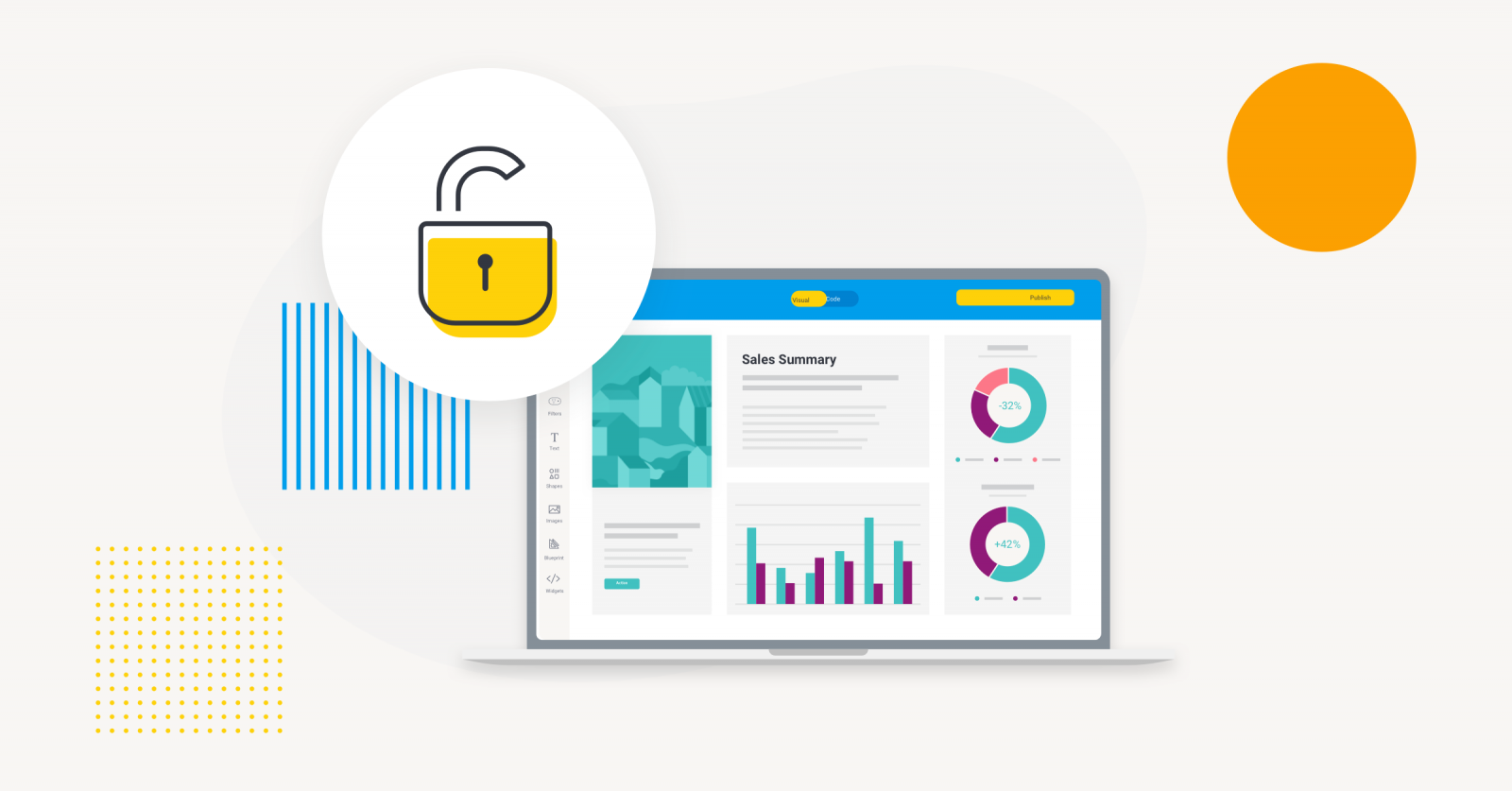
2. When you want to avoid complexity
Creating basic dashboards and reports with PBIE and then embedding them in your application is straightforward enough, but building more customized data-sets and visualizations, filters and analytics experiences involves proprietary programming languages such as Power Query's M language for data transformation or DAX (Data Analysis Expressions) for complex calculations. This necessitates specialized skill sets, increasing training and development overhead for teams not already familiar with Power BI and who want to get up-and-running fast. Understanding the nuances between Power BI Desktop, Power BI Service, and Power BI Embedded, along with their distinct features, also adds to an already steep learning curve, which may or may not be feasible for your team to handle.3. When you want to avoid unpredictable pricing
Despite its benefits, navigating Power BI embedded pricing, which is capacity-based and consumption-driven, can be challenging to predict and manage for varying usage patterns. Instead of paying per user, you pay for dedicated processing power through Azure SKUs (like A1 to A6). This model can be great for smaller applications with consistent usage, as you're essentially buying a set amount of computational resources. However, predicting costs becomes challenging as data grows or if your app experiences sudden spikes in user activity. To better understand the differences in licensing and pricing models among embedded analytics BI vendors, we recommend reading our guide, The Hidden Costs of Embedded Analytics: A Pricing Comparison, for more information.
4. When you want deeper customization and self service BI
One huge factor of the build vs buy analytics debate is that buying an already proven embedded analytics solution reduces development time and typically allows your company to integrate and customize the BI tool to look like a native part of your existing software application, helping create a seamless user experience and make analytic content look and feel like your brand (this is called white label analytics). The problem with Power BI is that it lacks full white label support compared to other vendors. Every user who accesses your embedded PBIE dashboards and reports will know it is Power BI, and deeper design and UI customization options are unavailable. Finally, embedded Power BI dashboard and reports offer limited self service analytics potential. End-users can access and consume the content within your application, but giving users the ability to create or modify the reports further requires investment in Power BI Pro licensing per user, which does not come with the default PBIE package. If you want to achieve self service BI among your customers or internal users, you are looking at additional costs to give them that important capability.5. When you need faster time to value
Power BI Embedded often requires significant upfront setup, including configuring Azure services, managing capacity-based infrastructure, and navigating licensing tiers. For product teams seeking to launch analytics features quickly or iterate rapidly based on user feedback, this initial complexity can delay go-to-market timelines. In time-sensitive scenarios, the overhead required to operationalize PBIE may outweigh its long-term benefits, especially for smaller teams or organizations with limited engineering resources.When should I move on from Power BI Embedded?
Power BI Embedded faces stiff competition in today’s business intelligence analytics market, with many competitors offering distinctive features catering to diverse needs while addressing its many gaps. PBIE’s key competitors include:- Yellowfin, known for flexible embedded analytics tools
- Tableau, renowned for data visualizations
- Looker, offering strong data integration
Best Power BI Alternative: Yellowfin BI
The neat thing about both Yellowfin and Power BI is they can easily co-exist in an organization, and you can leverage their individual strengths. Yellowfin is ideal for embedded BI use cases where you want to white label, re-style and integrate highly customized analytics directly into your internal or external applications. It is a great complementary solution to choose when you want to build a more accessible and sophisticated embedded analytics platform built to support ISV and enterprise use cases tailored toward operational reporting and self service analytics, has robust data governance, data security and analysis features, and which services a range of users. Unlike Power BI, Yellowfin relies on meta-data models that provide a more structured approach toward data and data governance. Yellowfin can also report from operational data sources and does not require proprietary data cubes, which makes it optimal for live data reporting. Let's cover some of the key differentiators between Power BI vs Yellowfin, to help provide you with a better understanding of which analytics suite can suit your use case needs:1) Data governance and data security
Data security (the practices, processes and tools that help protect your sensitive data) and data governance (the lifecycle management practices and accountability measures that help keep your data reliable) are two important considerations for any company buying a BI solution. Yellowfin places both data governance and security at the forefront, with several capabilities that help enforce protection and accountability over data sources.- Data security management: Yellowfin centralizes the tracking of data usage, management of deployment and optimization of the BI environment by enabling admins to view, manage and search system-wide configurations consisting of data sources, users (groups and roles) and metadata layers, all from one place via its Administration Console.
- Role-based access control (RBAC): Role-based access controls allows you to manage the available system functions within the application (report creation, data story authoring, etc) for individual users and their assigned role, in addition to links and permissions over what data is made available for reporting. RBAC is important to define control over what information is accessible and shareable among users based on their specific departments or needs, and Yellowfin offers highly flexible and easy-to-configure RBAC.
- Secure meta-data layer: Yellowfin provides a highly secure meta-data layer that sits between the user interface and the queries sent to the data-base. Meta-data is what describes each data object in a database, providing necessary context on the metrics within columns and rows (upload date, data formatting, type of data, etc). The meta-data layer is core to Yellowfin’s data security offering, with features such as Access Filters (configurable restrictions at the row-level on availability of data based on the user running a report), Column Level Security (ability to secure columns individually to protect sensitive information from being queried via self-service BI reporting only by those with proper role) and Data Source Substitution (multi-tenancy feature which enables the ability to switch what data source a report is running against based on the organization a user is part of when the report is run).
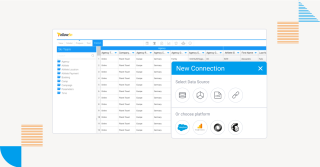
In comparison, Power BI is built on Azure, Microsoft's cloud computing infrastructure and platform, and its two-cluster architecture handles all connections, authentication and user interactions with the Power BI service. Power BI uses integrations with another Microsoft product, Azure Active Directory (Azure AD) to store and manage user authentication and user identities. Power BI users also have other data security concerns such as data storage and metadata handled via integrations with two further tools (Azure BLOB and Azure SQL Database).
In short, much of Power BI’s data security and governance is spread out across the Microsoft software-as-a-service ecosystem. Having much of its security functions spread across multiple programs can lead to complexity if your business is not all-into Microsoft’s software stack.
Some areas where Power BI falls short in comparison to Yellowfin include:
- Setup users from multiple domains
- Sophisticated governance and multi-tenancy
- Centralized reports with data sources in a multi-tenancy environment
- Approval processes for report creation
2) Hosting
Yellowfin is a 100% web-based BI suite in the cloud, designed to enable customers, from a number of different industries and sectors, with an effective way to modernize their existing homegrown or legacy reporting solutions that may no longer fulfill their users’ analytics requirements. Yellowfin is built around the foundations of openness and extensibility, and its approach is specifically designed around offering businesses many ways to deploy their Yellowfin embedded analytics software based on their own unique infrastructure and configuration choices.- Environment-agnostic flexibility: Whether it’s SaaS, MSP, or on-premises hosting, Yellowfin allows businesses to deploy their Yellowfin analytics instances in any environment they wish. Yellowfin will work with all major cloud providers (AWS, Azure, Google Cloud Platform, etc) as well as it will work on-premises in existing data centers.
- Extensive extensibility: Yellowfin provides businesses with several ways to extend its functionality, via creation of custom workflows, unique user experiences, code extensions, no code/low-code scripting, and more, which you can read about here.
- No vendor lock-in: Yellowfin grants you access to the source code of the platform in the event of insolvency on the part of Yellowfin, and access to your content design and code extensions, which you fully own and can use towards reengineering efforts. Your data can be stored inside any database of your choice, and is owned and accessible to you at all times. There is also no proprietary database or proprietary scripting language to move, store or access data.
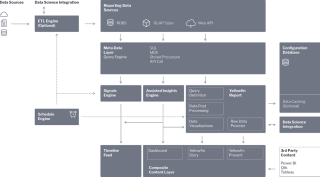
Above is a visualized diagram of the key components of Yellowfin’s architecture and hosting structure. For more information, please visit this page on Yellowfin technical architecture.
Power BI is designed to drive the adoption of Microsoft Azure cloud first and foremost and by default has more limited hosting options. Because of this, Power BI is not suited to support easily build proprietary embedded SaaS offerings, leading to potential implementation and technical complexities. Key limitations of Power BI in the hosting area include:
- Limited on-premises options - many doubt that MS will support this long-term
- Difficult to package your own SaaS solutions
- Optimized to run on Azure - it can leverage other clouds for data
- Some security needs to be handled through infrastructure
3) Functionality
Functionality is a very broad category with ambitious roadmaps for all vendors. Many customers argue that there may be in fact too many many features in analytics platforms that are frequently not that relevant or utilized across the suite, and major advances in technologies such as Natural Language Query (NLQ) and artificial intelligence (AI) are likely going to be slow to gain day-to-day applications, despite the hype. Below, we focus on the core features that are fundamental for most BI deployments, but which present challenges for many organizations today:- Limitations on scheduling and refresh for import datasets (8x/48x/day) with premium cost model
- Direct data access (Direct query) also has limitations that will improve with ‘Fabric’, but will face similar cost implications
- Old-school reporting (paginated) not fully integrated
- DAX (collections of functions, operations, and constraints) is getting more complex, not dissimilar to Excel ++
- Handling of huge amounts of data getting complex and expensive due to fundamentally different approach in data handling (SQL generation vs. Import)
- Data storytelling out of the box being complicated to implement
- Full integration into the application and white labeled
- Support advanced data analysts or casual business users (AI NLQ) for centralized operational analytics
- Self-service BI with a focus on operational analytics vs data science use cases
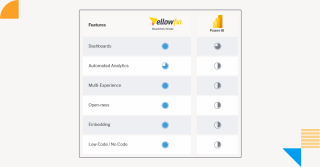
A summary comparison of Yellowfin vs Power BI in terms of features and services.

4) Business model
Power BI and Yellowfin differ significantly in business models. Yellowfin originates in the embedded BI and white labeling use cases that require significant flexibility and allow for revenue share, value-based pricing, etc. Power BI evolved and owes its success to the proven Microsoft freemium model. It is meant to be ubiquitous, similar to Excel, but also drives Azure use and covers more enterprise use cases to generate meaningful revenue. Here are some key considerations for businesses comparing Power BI with Yellowfin:- Power BI is fairly cheap or free to start - in a typical MS model, you get it as part of their bundle of offerings, but generally Pro can start as little as $10 per user per month. However, premium and enterprise features add up, so you should take time to develop an “apples-to-apples comparison.”
- Power BI is ultimately designed to drive Azure usage - with the new Fabric model, you will likely have even fewer capabilities outside of Azure.
- Limited revenue share and value-based models - even large companies are probably too small for Microsoft to care about developing anything custom, which is not a problem for standard use cases, but anything embedded and/or more integrated to your go-to-market (GTM) strategy will be difficult to address with Power BI.
Power BI vs Yellowfin - Which is Better?
Both Power BI Embedded and Yellowfin BI have robust functionality that will meet analytics requirements for customers. PowerBI Embedded is easy to adopt and use in many parts of an organization that is already invested in using tools from the Microsoft software stack. However, there is a reason that Excel, despite its power is not used for enterprise analytics, or companies did not build applications with it. Centralized or embedded / white-labeled use cases require both specific functionality and a business model that are different from generic BI solutions. Yellowfin was built to address such use cases. Modern organizations will likely have two or three BI tools (many have quite a bit more, but that is not necessary). At the end of the day, Yellowfin BI and Power BI can live well together and excel in their own areas of expertise, with Yellowfin being the best alternative for embedded BI. Get a step-by-step migration roadmap and more detailed features comparison of Power BI vs Yellowfin in our Power BI to Yellowfin Migration Guide, which you can download for free below.